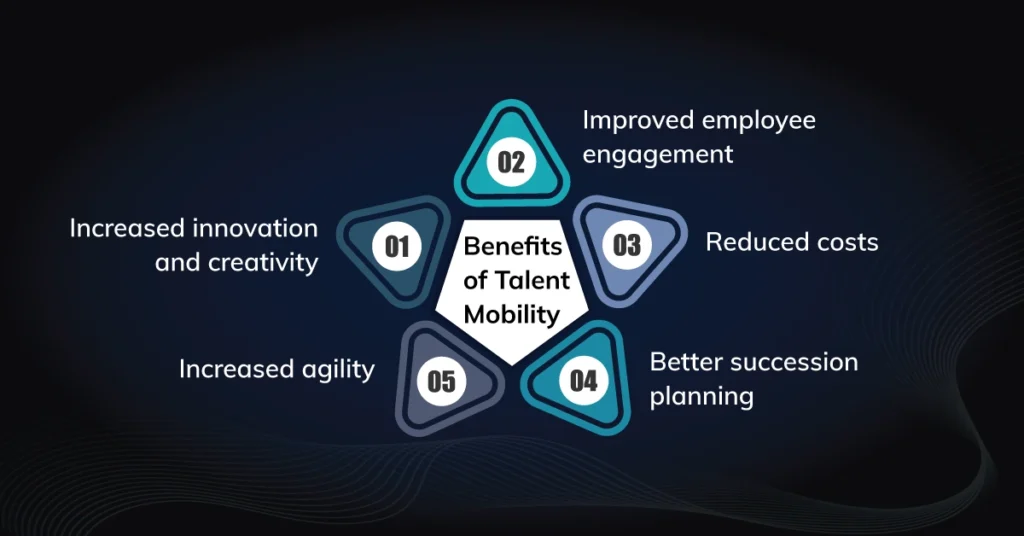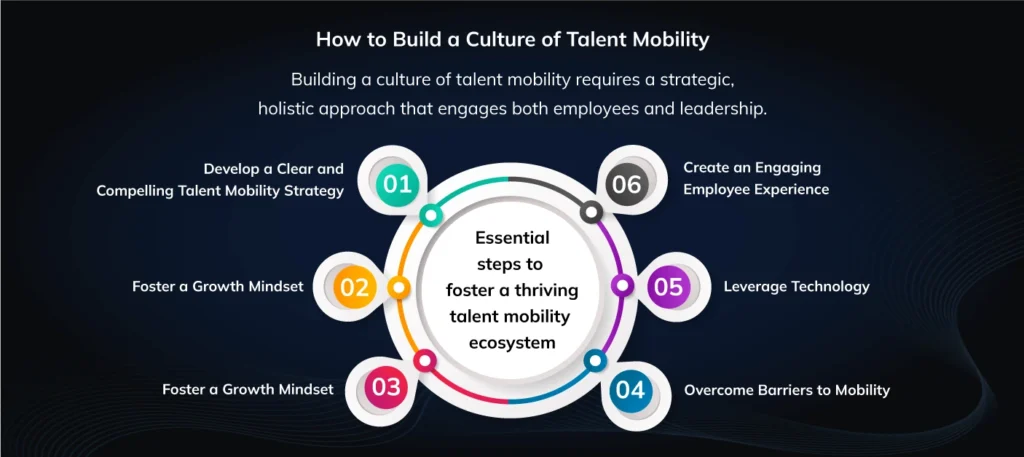Talent mobility goes beyond simply filling vacant positions; it encompasses a holistic approach to developing and deploying talent across the organization. Organizations can unlock many benefits by creating a culture that encourages employee movement and development, including increased innovation, improved employee engagement, reduced costs, enhanced succession planning, and greater agility.
However, realizing the full potential of talent mobility requires a concerted effort and the right tools. Traditional HR systems often fall short in supporting internal talent movement, hindering organizations’ ability to leverage their human capital effectively. To overcome these challenges and build a successful talent mobility strategy, organizations must invest in technology solutions specifically designed to facilitate and optimize internal talent movement.
This blog will provide practical advice for leaders on creating an organizational environment that supports employee movement and growth. Let’s start with the basics and then move on to the essential tips for enhancing your organization’s talent mobility.
What is Talent Mobility?
Talent mobility is the strategic movement of people within an organization to fill critical roles, develop new skills, and advance careers. Along with filling open positions, it’s also about creating a culture where employees are encouraged to grow and develop their skills and where the organization systematically identifies and develops talent for future needs.
Talent mobility is the strategic movement of people within an organization to fill critical roles, develop new skills, and advance careers.
The Challenge of Traditional Systems
Despite the clear benefits of talent mobility, many organizations struggle to implement it effectively. A significant barrier is the lack of specific technology to support and optimize internal movement. Traditional HR systems often focus on transactional tasks like payroll and benefits rather than providing the tools and insights needed to facilitate talent mobility.
Traditional HR systems often focus on transactional tasks like payroll and benefits, rather than providing the tools and insights needed to facilitate talent mobility.
Benefits of Talent Mobility
When organizations successfully implement talent mobility, they can reap numerous benefits, including:
- Increased innovation and creativity: When employees are exposed to new ideas and perspectives, it can lead to increased innovation and creativity. Talent mobility can help to break down silos and encourage collaboration between different teams.
- Improved employee engagement: Employees who feel they have opportunities to grow and develop are more likely to be engaged and productive. Talent mobility can help to give employees a sense of ownership over their careers and a path for advancement.
- Reduced costs Talent mobility can help to reduce costs associated with recruiting and onboarding new employees. By developing talent from within, organizations can avoid the time and expense of going through the external hiring process.
- Better succession planning: Talent mobility can help organizations develop a pipeline of qualified candidates for future leadership roles. Organizations can ensure a smooth transition when key positions become vacant by identifying and developing high-potential employees early on.
- Increased agility: In today’s rapidly changing business environment, organizations must adapt quickly to new challenges and opportunities. Talent mobility can help organizations to develop a more agile workforce that can respond to change.
How to Build a Culture of Talent Mobility
Building a culture of talent mobility requires a strategic, holistic approach that engages both employees and leadership. Here are some essential steps to foster a thriving talent mobility ecosystem:
Develop a Clear and Compelling Talent Mobility Strategy
- Define your organization’s goals: Clearly articulate the business objectives that talent mobility will support, such as innovation, cost reduction, or agility.
- Identify key roles: Determine the critical positions that require high levels of talent mobility.
- Create career paths: Develop clear and accessible career paths for employees, outlining potential progression within the organization.
- Establish performance metrics: Define key performance indicators (KPIs) to measure the success of your talent mobility initiatives.
Foster a Growth Mindset
- Champion continuous learning: Create a culture where learning and development are prioritized. Offer various training and development opportunities, including on-the-job training, mentorship, and external certifications.
- Encourage skill development: Provide resources and support for employees to acquire new skills and expand their skill sets.
- Promote a growth mindset: (IDPs): Foster a workplace culture where employees are encouraged to embrace challenges, learn from failures, and seek new opportunities.
Build a Supportive Leadership Team
- Communicate the value of talent mobility: Clearly articulate the benefits of talent mobility to leaders at all levels.
- Empower managers: Equip managers with the tools and resources to support employee development and mobility.
- Encourage cross-functional collaboration: Break down silos and foster collaboration between different departments.
Create an Engaging Employee Experience
- Transparent communication: Keep employees informed about career opportunities, development programs, and internal job postings.
- Employee development programs: Offer a range of development programs tailored to different career stages and aspirations.
- Mentorship and coaching: Provide opportunities for employees to connect with mentors and coaches to support their career growth.
- Reward and recognition: Implement a rewards and recognition system that acknowledges and celebrates employee mobility and development.
Leverage Technology
- Talent management systems: Invest in technology tracking employee skills, preferences, and career aspirations.
- Internal job boards: Create a centralized platform for posting and applying for internal job opportunities.
- Performance management tools: Use performance management systems to identify high-potential employees and their development needs.
- Learning management systems: Provide access to various learning resources and track employee development progress.
Overcome Barriers to Mobility
- Address compensation concerns: Develop fair compensation and benefits policies for internally moving employees.
- Manage manager resistance: Provide training and support to managers to help them embrace talent mobility.
- Create a supportive work environment: Foster a culture of open communication, collaboration, and flexibility.
By implementing these strategies and fostering a supportive environment, organizations can create a thriving culture of talent mobility that benefits both employees and the business.
How Spire.AI Can Help Enhance Talent Mobility
Spire.AI is an AI Copilot for Talent that supports the evolving talent operating model requirements of all talent stakeholders of future-ready companies transforming into Skills-Based Organizations (SBOs). Spire.AI’s full-stack SaaS talent solutions are powered by an integrated, adaptive, and transparent domain-intelligent Generative Skills AI Platform to simplify and future-proof how talent is acquired, deployed, managed, reskilled, grown, and retained.
Here are some of the ways that Spire.AI can help organizations build a culture of talent mobility:
- Auto-evolving Role-Skill Framework: Spire.AI’s auto-evolving role-skill framework helps organizations identify the skills needed for future roles and create clear career paths for employees. This framework provides a foundation for talent mobility by helping organizations understand the skills gaps that need to be filled and develop plans for closing those gaps.
- Talent Marketplace: Spire.AI’s Talent Marketplace creates a platform for employees to discover internal opportunities and for managers to find the right talent for their teams. By making it easy for employees to find new opportunities, Spire.AI can help increase internal mobility and promote a continuous learning and development culture.
- AI-generated Skill Profiles: Spire.AI’s AI-generated skill profiles provide employees with a clear understanding of their skills and how they align with organizational needs. This information can help employees to identify potential career paths and to develop a plan for acquiring the necessary skills.
- Career Path Simulation and Reskilling Recommendations: Spire.AI’s career path simulation and reskilling recommendations help employees visualize their potential career paths and identify the steps they need to take to achieve their goals. This information can be used to create personalized development plans and to support employees in their career journeys.
- Talent Acquisition: Spire.AI’s talent acquisition capabilities can help organizations identify and attract talent for their mobility programs. Using AI to match candidates with open positions based on skills and experience, Spire.AI can help organizations find the best talent for their needs.
By leveraging Spire.AI’s AI-powered tools and insights, organizations can create a more agile and responsive workforce, improve employee engagement and satisfaction, and achieve better business outcomes.
Conclusion
Building a culture of talent mobility is essential for organizations that want to remain competitive in today’s rapidly changing business environment. By taking the steps outlined in this blog and leveraging the power of AI-powered tools like Spire.AI, leaders can create an organization where employees are empowered to grow and develop their careers and where the organization has a ready supply of talent to meet its future needs.
By fostering a culture of talent mobility, organizations can unlock the full potential of their workforce and achieve greater success.








